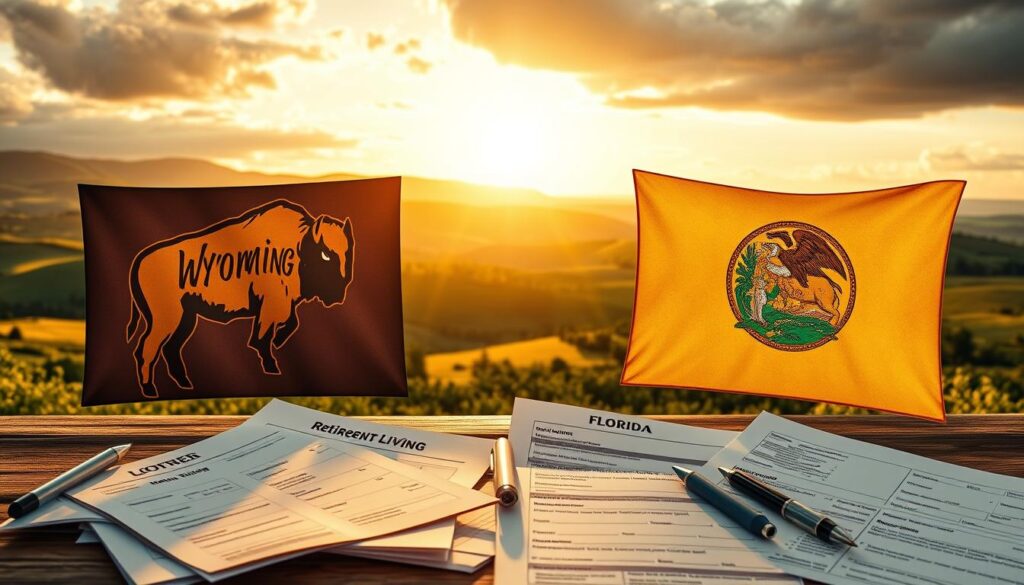Surprising fact: median U.S. home prices hit $435,300 in June 2025, while some couples may face up to $413,000 in retirement medical bills.
I set the goal up front: I will define the financially optimal place for retirement by blending taxes, cost of living, healthcare access, and lifestyle benefits into one clear, data-backed answer.
I explain why tax structure matters: income, property, and sales levies can change your monthly cash flow dramatically. I preview my dual-filter method: Tax Foundation’s 2025 competitiveness rankings plus millionaire-filer density to find places that are efficient and desirable.
Early leaders appear quickly: Wyoming and Florida show strong tax advantages and solid average savings and net worth for residents. I’ll compare those options head-to-head and map practical alternatives you can model into digital planners.
My promise: clear recommendations, transparent assumptions, and actionable steps that help lower taxes, preserve income, and boost quality of life.
Key Takeaways
- I define the financially optimal retirement place using taxes, housing, healthcare, and lifestyle.
- Tax policy often shifts more dollars than small savings on housing.
- Wyoming and Florida rank high on competitiveness and resident wealth metrics.
- High home prices and medical costs make location efficiency critical now.
- I will deliver a head-to-head comparison and clear, actionable steps.
Search intent decoded: finding the financially best state to retire in right now
Finding a place that stretches retirement savings without cutting lifestyle demands a clear decision framework. I clarify intent: you want a location that stretches every retirement dollar and keeps the daily living experience you value.
I translate that goal into measurable factors: total tax burden, housing and essentials cost, medical spend range, and local amenities that affect quality of life. I prioritize present-day relevance: shifting housing markets and rising healthcare needs matter most for retirees in 2025.
I recommend a shortlisting approach. Start with no-income-tax states (AK, FL, NV, NH, SD, TN, TX, WA, WY), then screen for property tax levels, sales tax exposure, and senior relief programs. Pick two or three candidates that match climate, ocean access, or quieter communities, then model after-tax income and expenses.
| Shortlist | Tax perks | Cost & housing | Healthcare & living fit |
|---|---|---|---|
| No-income-tax list | Lower state income exposure | Varies widely; coastal areas cost more | Urban centers give better medical access |
| Screening criteria | Property tax, sales tax, exemptions | Median home price impact | Medicare plans, hospital networks |
| Next steps | Run modeled budgets | Compare after-tax income | Check neighborhoods and local benefits |
Action: shortlist two or three locations, then test real budgets and healthcare availability. I’ll follow with head-to-head comparisons that show which options keep more income and match your lifestyle.
How we evaluated states: taxes, cost of living, healthcare access, and lifestyle
I built a scorecard that mixes tax structure, housing pressure, and healthcare reach to spot efficient options.
Why a scorecard: raw tax numbers miss real-world effects. I rely on the Tax Foundation’s 2025 competitiveness index to capture effective state tax structure across income, sales, property, corporate, and excise dimensions.
I layer millionaire-filer density over that index as a lifestyle proxy. High concentrations often signal stronger amenities, hospitals, and cultural options that matter for long-term well-being.
- Housing weight: median existing home price ($435,300) drives cost living outcomes.
- Healthcare: Medicare plan availability and likely out-of-pocket swings (some couples may need up to $413,000).
- Risk adjust: penalize volatile property taxes unless senior relief exists; discount net perks when sales tax erodes fixed income.
| Factor | Source | Practical impact |
|---|---|---|
| Overall tax competitiveness | Tax Foundation 2025 | Shows effective burden beyond headline tax rates |
| Millionaire-filer density | IRS filer concentration | Proxy for amenities, medical access, cultural fit |
| Housing & healthcare | Market data & Medicare networks | Affects safe withdrawal and monthly cash flow |
Data snapshot: top tax-competitive states and millionaire hotspots
C
Most tax-friendly list (2025): Wyoming, South Dakota, Alaska, Florida, Montana, New Hampshire, Texas, Tennessee, North Dakota, Indiana.
Millionaire concentrations (per 10,000 filers): Connecticut, Massachusetts, New York, Florida, California, New Jersey, Wyoming, Washington, Nevada, Texas.
Why both matter: tax rankings show broad fiscal advantages; millionaire clusters act as a lifestyle proxy for hospitals, services, and cultural benefits. Overlap points — notably Florida, Wyoming, Texas, and Nevada — often signal places that blend low tax rates with strong amenities.
- I flag South Dakota, New Hampshire, and Tennessee as notable tax performers, but county property and sales dynamics can change outcomes.
- Treat this snapshot as a starting filter: run local income modeling, check county levies, and confirm healthcare network adequacy.
| Signal | Top examples | Practical note |
|---|---|---|
| Tax competitiveness | Wyoming, South Dakota | Low overall tax burden |
| Wealth clusters | Connecticut, Florida, California | Stronger amenities, higher costs |
| Overlap | Florida, Wyoming, Texas | Good mix of savings and services |
Head-to-head: Wyoming vs. Florida for the financially best retirement
A head-to-head look helps reveal how taxes, housing, and healthcare move retirement dollars. I compare practical effects so you can model after-tax cash flow and lifestyle trade-offs.

Taxes and income: treatment and wealth transfer
Both states have no state income tax and exclude Social Security from taxation. That preserves pensions, 401(k)/IRA withdrawals, and core retirement income.
Florida also lacks estate and inheritance taxes, simplifying legacy planning. Wyoming keeps overall state and local tax burdens low, which helps long-run savings.
Cost variables: housing and property differences
Florida shows wide home-price dispersion: some markets beat national averages, while metros can be costly.
Wyoming supplies limited inventory; resort towns drive premiums. Florida’s homestead exemptions and assessment caps can lower property carry for owners.
Lifestyle and access: healthcare and community fit
Florida offers dense medical networks, many Medicare Advantage options, beaches, and golf courses.
Wyoming delivers outdoor living and quiet communities, but specialized care may require travel.
| Factor | Wyoming | Florida |
|---|---|---|
| Income tax | No | No |
| Estate/inheritance | No state tax | No state tax |
| Property relief | Modest taxes | Homestead exemptions |
| Healthcare access | Regional hubs | Dense networks, many plans |
My take: for retirees who value Medicare access and amenities, Florida usually edges ahead. For those seeking low overall taxes and quieter living, Wyoming can fit better.
Strong alternatives: Texas, New Hampshire, and Montana compared
I compare three strong alternatives that often balance tax savings with real-world living costs.
Texas: No state income tax preserves retirement withdrawals and social security benefits. Property taxes run high, but homestead exemptions and caps can reduce one’s annual burden.
New Hampshire: Highly competitive on tax measures: no general sales tax and no wage income tax. Property taxes, however, tend to be above average; plan budgets around local levies and senior relief programs.
Montana: Ranked tax-competitive overall. Sales tax exposure is low, though some retirement income may face taxation depending on thresholds.
Tax structure and Social Security benefits treatment
Social security benefits are not taxed by Texas or New Hampshire. Montana may tax benefits when combined income crosses state limits; check thresholds before moving.
Property taxes and homestead-style relief considerations
Homestead protections in Texas can stabilize home assessments. New Hampshire and Montana offer county-level credits and deferrals; these programs can matter more than headline tax ranks for many retirees.
“Match tax rules to lifestyle: sometimes relief programs matter more than a zero income tax label.”
| Factor | Texas | New Hampshire | Montana |
|---|---|---|---|
| Income tax | No | No wage income tax | Yes (selective) |
| Social Security benefits | Not taxed | Not taxed | May be taxed |
| Property taxes | High; homestead relief | Relatively high; local relief | Moderate; local programs |
| Housing markets | Affordable outside metros | Varies by town; premium for good schools | Value outside resort areas |
- Fit advice: pick Texas for scale and amenities, New Hampshire for no sales tax and New England life, Montana for outdoors with competitive taxes.
- Action: model after-tax income, include property tax scenarios, and confirm local relief details before deciding.
Contrast case: high-tax states and the impact on fixed income
High local levies can quietly shrink a fixed retirement check faster than most people expect.
I show how layered taxes erode spending power when retirement distributions, pensions, and benefits face multiple layers of tax.
When retirement distributions, pensions, and benefits face multiple layers of tax
In Nebraska, for example, most retirement income is taxable and property tax rates run high. That combination raises total burdens for many seniors.
Some states add higher sales taxes on top of income and property levies. Places like Tennessee and Louisiana can push combined consumption burdens above 9.5%.
| Example | Key burden | Practical effect |
|---|---|---|
| Nebraska | Taxed retirement income, high property tax | Lower monthly spendable cash |
| Tennessee / Louisiana | Higher sales tax + other levies | Costly everyday purchases |
| Wyoming | No income tax, low property/sales | Preserves more cash flow |
Compound burdens matter: income tax on withdrawals plus elevated property and sales levies can strain a fixed income quickly.
“Run a net spendable analysis: compare your current after-tax withdrawals to what you’d keep after property and sales levies in a new location.”
- I recommend modeling after-tax retirement income and routine living expenses side-by-side.
- Migration from a high-burden area to a low-burden one can raise your after-tax yield without taking extra portfolio risk.
- Even strong pensions get squeezed when multiple tax layers apply to both distributions and daily purchases.
Social Security benefits: which states tax them and what’s changing
I review how state treatment of social security benefits changes take-home pay and planning choices for retirees.
Nine states still tax social security benefits in 2025: Colorado, Connecticut, Minnesota, Montana, New Mexico, Rhode Island, Utah, Vermont, and West Virginia. Missouri, Kansas, and Nebraska removed taxes on benefits beginning in 2024. West Virginia will finish phasing out its levy by 2026.
Important nuance: many taxing states offer deductions, credits, or income thresholds that shield lower- and middle-income retirees. That means a portion of benefits can remain untaxed until combined income crosses the limit.
States taxing Social Security in 2025 and recent phase-outs
Colorado, Connecticut, Minnesota, Montana, New Mexico, Rhode Island, Utah, Vermont, and West Virginia tax some benefits now.
Recent policy moves — like Missouri, Kansas, and Nebraska eliminating their taxes — show momentum toward relief in several regions.
How exemptions, credits, and income limits affect retirees
Exemptions vary: some states exclude benefits below a MAGI threshold; others provide flat deductions. Higher earners who take large RMDs often trigger more state-level tax on social security.
Planning tip: model Modified Adjusted Gross Income scenarios and sequence withdrawals so provisional income stays lower. That reduces the chance state tax on benefits will bite after RMDs begin.
Compare state retirement tax rules before moving. Federal taxation still applies, but state taxes can materially change net outcomes for retirees.
Retirement income, pensions, and RMDs: where taxes bite and where they don’t
Retirement withdrawals and pension rules can turn a small tax rate into a meaningful annual bill. I separate locations into two clear buckets: jurisdictions with no-income-tax and places that offer targeted exclusions for retirement income or pensions.
No-income-tax jurisdictions (Alaska, Florida, Nevada, New Hampshire, South Dakota, Tennessee, Texas, Washington, Wyoming) provide straightforward relief: withdrawals and RMDs face no state levy. That can leave more monthly cash for living expenses or care.
Targeted exclusions matter too. Some states—Mississippi among them—exclude retirement account income or grant pension deductions. Those rules can cut your state tax bill even when a state keeps general income levies.
Practical comparison
Example: a 4% effective rate on $30,000 of 401(k) withdrawals equals $1,200 a year in state tax. In a no-income-tax jurisdiction that number drops to $0. That gap compounds over decades and affects estate planning and long-term cash flow.
| Category | Examples | Practical effect |
|---|---|---|
| No-income-tax | Alaska, Florida, Texas | Zero state tax on withdrawals; preserves spending power |
| Retirement exclusions | Mississippi, some Midwest states | Partial relief; may exempt pensions or IRAs |
| RMD impact | All states with income levies | RMDs can push you into higher state tax brackets; consider Roth conversions |
- Check whether public and private pensions are treated differently by law.
- Model your expected withdrawal mix—pensions vs. IRAs vs. taxable income—before moving.
- Plan Roth conversions before RMDs start to reduce future state exposure and protect estate value.
“Anchor your location choice to how you’ll draw income; tax rules hit distributions more than buckets on paper.”
Property taxes and senior relief: why location can make or break your housing budget
Annual property bills often matter more than headline income tax rates when you hold a home long-term. I use stark contrasts to make the point: New Jersey homeowners average $9,345 a year, while Alabama owners average $701.
High vs. low burdens and relief mechanics
Many states offer homestead exemptions that cut assessed value, and circuit breakers that cap increases for seniors. These benefits stabilize bills for qualified owners.
Deferrals: freeing cash flow by delaying payments
Some programs let you defer property payments until sale. That converts current liabilities into a lien, freeing monthly cash for medical or living needs.
- Eligibility often hinges on age and income limits — check rules before buying.
- County millage rates vary; local due diligence matters as much as statewide rank.
- Model full housing cost: mortgage, insurance, maintenance, HOA, and after-relief property taxes.
“Run scenarios: a low income tax won’t help if local property levies erase those savings.”
Sales taxes and day-to-day spending: the hidden drain on a fixed budget
Daily purchases add up quickly: even small levies shave fixed checks over a year. I flag sales as an easy-to-miss expense that compounds when you shop for groceries, meds, and services.

No-sales-tax examples include Delaware, Montana, New Hampshire, and Oregon. Alaska has no state sales tax but some local levies. At the other end, combined averages top 9.5% in places like Louisiana and Tennessee.
Why it matters: exemptions for groceries, prescriptions, and medical devices can blunt the effect. Your personal spending basket matters more than statewide averages.
- Budget by category: estimate annual purchases for groceries, meds, dining, and services.
- Layer analysis: add sales results to property and income math for a true tax picture.
- Cross-border shopping: living near a no-sales-tax neighbor can lower annual outlays.
Practical step: run a simple annual spend model. Multiply typical purchases by local sales rates to reveal the hidden drag on income.
Estate and inheritance taxes: preserving more of your legacy
A careful look at estate and inheritance levies reveals hidden drains on family legacies.
The federal estate exemption is $13.99 million in 2025, but twelve states plus Washington, D.C. still impose a separate estate levy. Nine of those have exemptions at $5 million or less. Oregon stands out with a $1 million threshold that can affect middle-wealth households.
Where estate rules apply and typical exemption levels
Estate taxes are charged against the estate before distributions. In contrast, inheritance levies hit recipients directly. Six jurisdictions collect inheritance taxes; Maryland collects both systems, which complicates multi-generational planning.
Family exemptions and practical steps
Many inheritance taxes offer reduced rates or exemptions for spouses and close relatives. That softens impacts for heirs but still requires careful titling and trust choices.
| Rule | Practical note | Example |
|---|---|---|
| Federal exemption | Protects estates under $13.99M | 2025 level |
| Low state exemptions | Can tax mid-sized estates | Oregon: $1M |
| Inheritance rules | Recipient-based; family relief common | Md: both estate & inheritance |
“Align domicile, titling, and trust strategy with local rules to simplify legacy transfer.”
- Action: check your prospective domicile’s estate and inheritance rules.
- Action: use spousal exemptions and trusts to preserve benefits for family.
Lifestyle and healthcare access: matching your priorities to the right state
Start by mapping your ideal living scene: beaches, golf courses, parks, or a quiet country town. Then layer in healthcare capacity, travel time, and family proximity.

Climate, community, and amenities
Florida and South Carolina score high for coastal living, active adult communities, and plentiful golf courses. Arizona delivers sun and major specialist centers like the Mayo Clinic in Phoenix.
Delaware offers no sales tax and compact coastal towns. Tennessee blends a lower cost with growing hospital networks in cities.
Medicare plans, premiums, and out-of-pocket costs
Plan availability matters: Medicare Advantage choices, Part D premiums, and Medigap rates vary by county. That can change your annual medical cost.
Action: check local plan counts and premium ranges before choosing housing. Map hospitals and specialists within 30–60 minutes of preferred neighborhoods.
- Renting in an active community can lower upfront housing cost and give trial time.
- Owning offers stability and homestead benefits in some places—factor property relief into your cost plan.
- Schedule extended stays in peak and off-peak seasons to validate climate and community fit.
| Example | Healthcare anchor | Living advantage |
|---|---|---|
| Florida | Dense provider networks | Coastal living, many retirees |
| Arizona | Mayo Clinic hub | Outdoor lifestyle, sunny climate |
| South Carolina | Expanding hospitals | Lower cost of living |
“Match amenities to your health plan landscape — that keeps housing and care costs predictable.”
Next step:shortlist two spots, run housing and med-cost models, and book extended visits with family and airport travel time in mind.
Conclusion
This conclusion gives clear next steps so you can test top candidates quickly.
Florida and Wyoming emerge as the leading picks among the best states for a low-tax, high-amenity retirement. Texas, New Hampshire, and Montana work well for specific profiles that tolerate property or access trade-offs.
Model full costs: include housing, healthcare, and taxes. Run after-tax budgets for how your income and home will hold up over time. Use local plan lists and price checks as you compare cost living across towns.
Pay attention to estate and inheritance rules: federal shelter is $13.99M, but some jurisdictions keep lower thresholds that affect legacy plans for families of all sizes.
Take time: scout two or three finalists, validate local data, and simulate scenarios with modern planning tools before moving. That process lets retirees choose a country-fit that keeps cash flow and lifestyle aligned.

